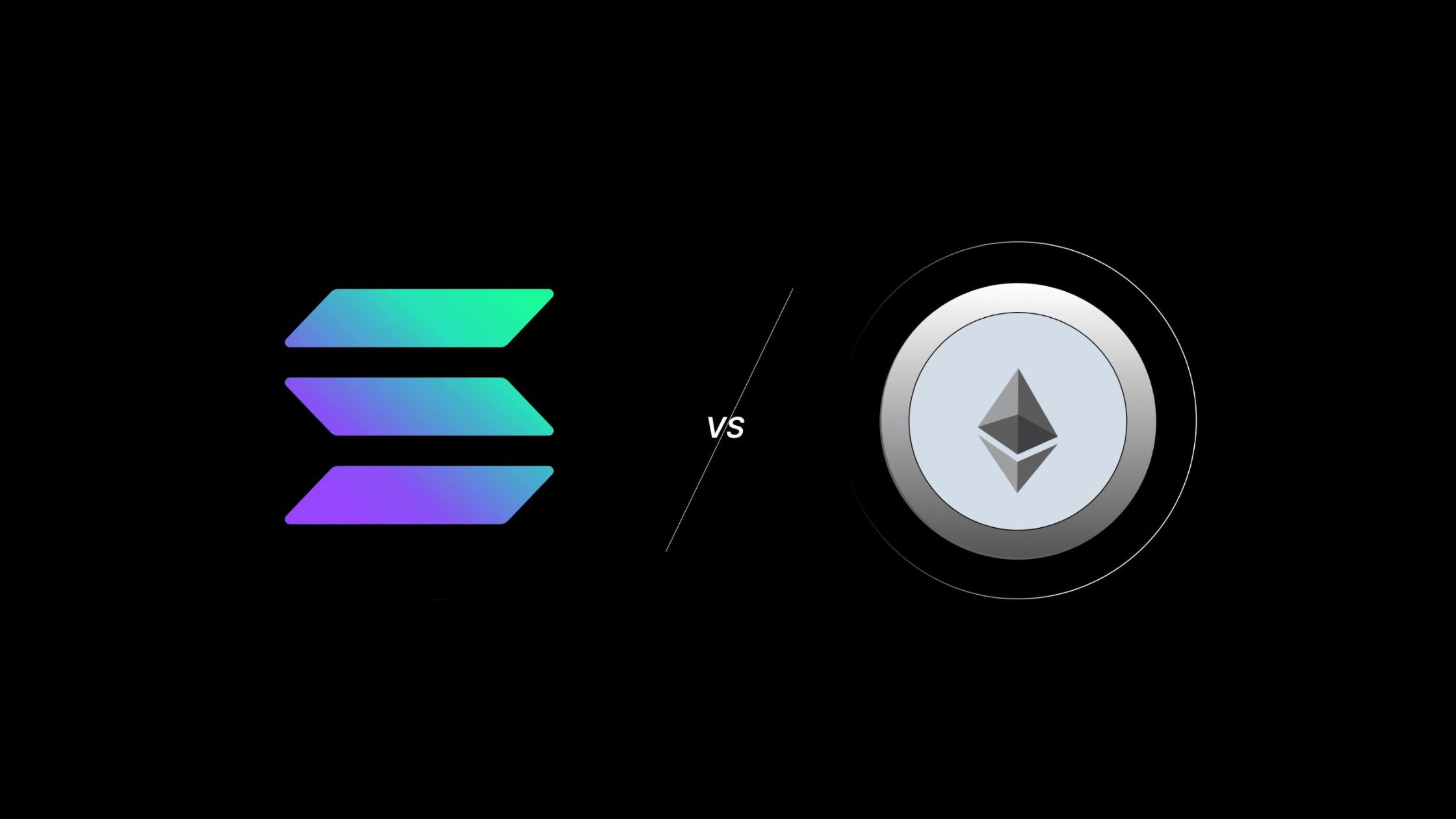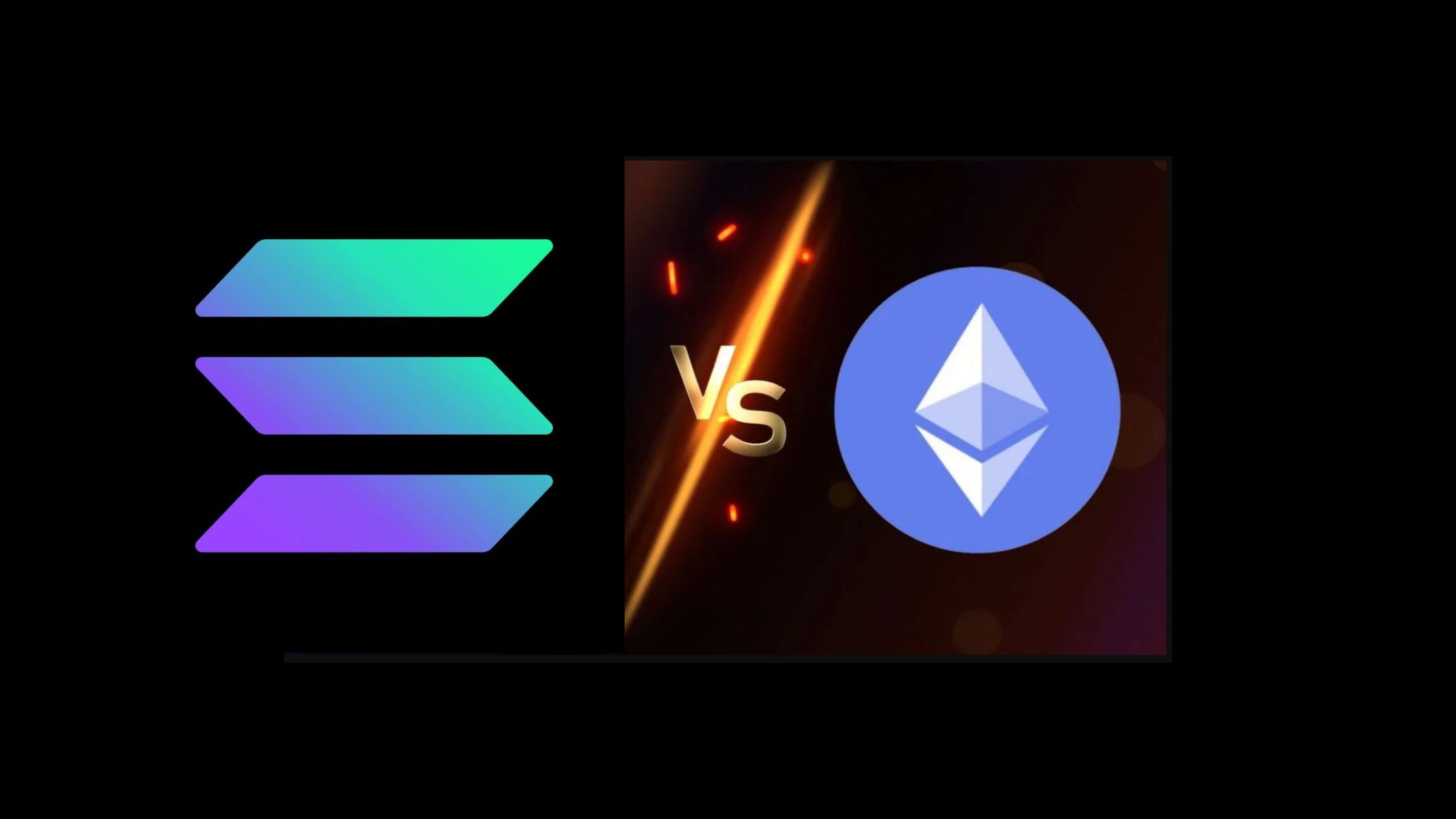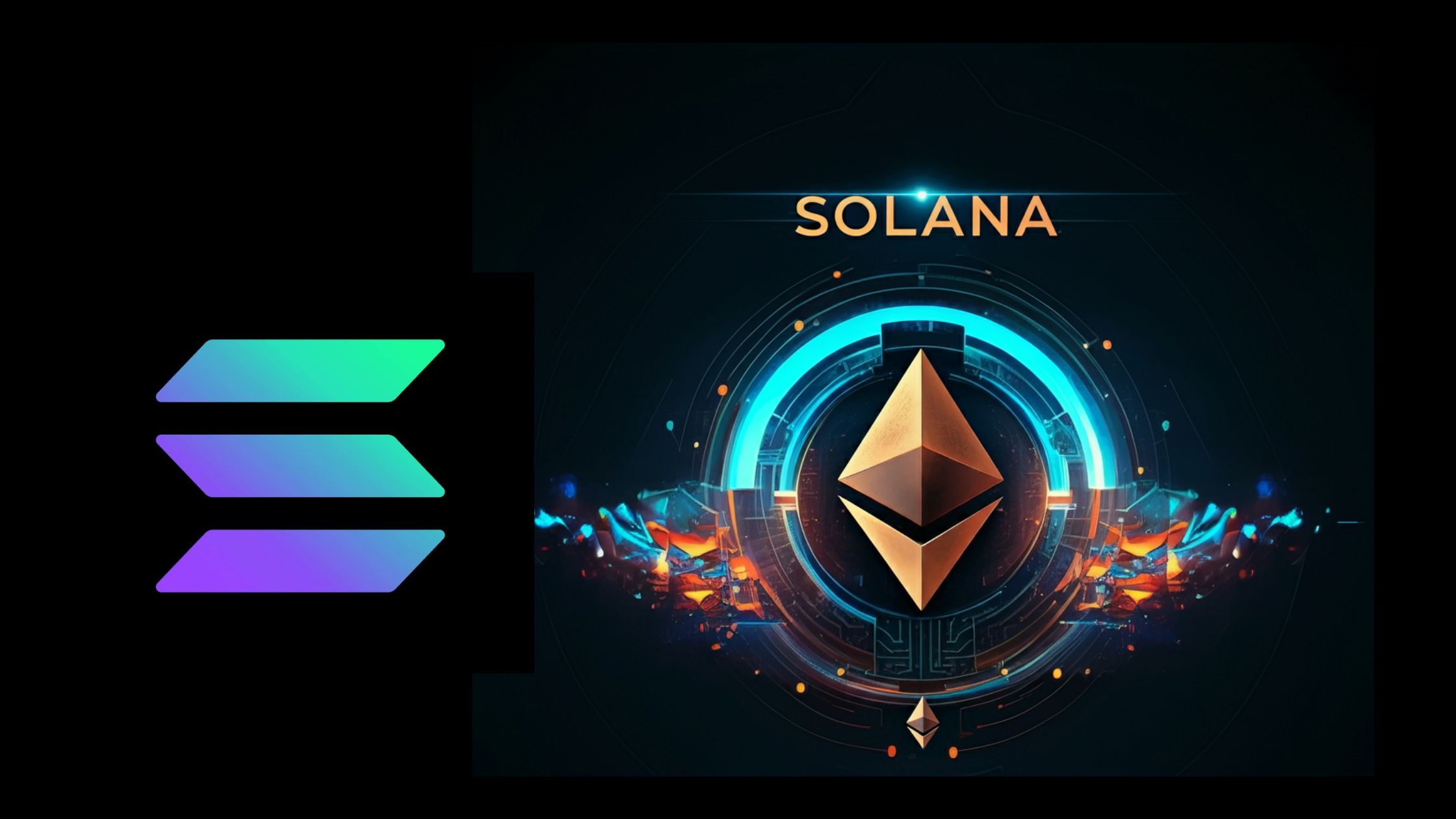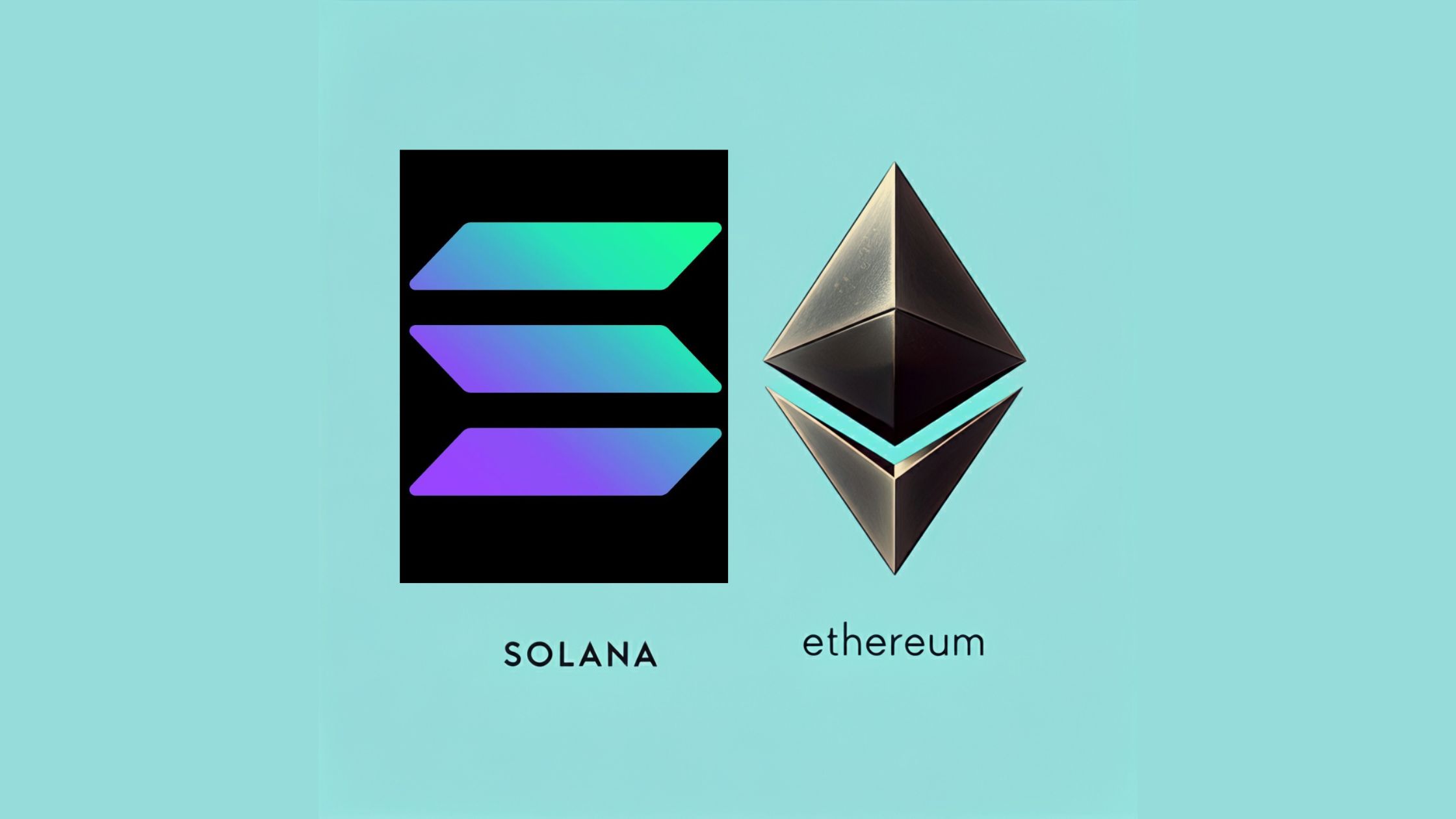In this blog post, we’ll compare Solana vs Ethereum, and the key differences between Solana and Ethereum, including their scalability, security, smart contract capabilities, and investment potential. We’ll also examine the potential scenarios that could play out in the future, from Solana overtaking Ethereum to the two blockchains coexisting and serving different purposes.
What is Solana vs Ethereum?
Solana (SOL) and Ethereum (ETH) are two popular blockchain platforms with distinct differences.
Ethereum (ETH)
1. Launched in 2015 by Vitalik Buterin: Ethereum is a pioneering smart contract platform that has enabled the creation of decentralized applications (dApps) and decentralized finance (DeFi) ecosystems.
2. Smart contract platform: Ethereum’s core innovation is its ability to execute self-enforcing, self-executing contracts with the rules of the agreement written directly into lines of code.
3. Turing-complete programming language (Solidity): Ethereum’s smart contracts are written in Solidity, a programming language that allows for complex logic and functionality.
4. Proof-of-work (PoW) consensus algorithm (planning to transition to proof-of-stake (PoS)): Ethereum currently uses a PoW consensus algorithm, but is planning to transition to a more energy-efficient PoS algorithm, which will allow for faster transaction processing and greater scalability.
5. Slower transaction processing (around 15-20 transactions per second): Ethereum’s PoW consensus algorithm limits its transaction processing capacity, making it slower compared to newer blockchains.
6. Higher gas fees: Ethereum’s gas fees are higher due to network congestion and the computational resources required to execute complex smart contracts.
7. Larger developer community and ecosystem: Ethereum has a vast and established developer community, with a wide range of tools, frameworks, and libraries available for building dApps.
8. More decentralized applications (dApps) and use cases: Ethereum has a broader range of dApps and use cases, including DeFi, non-fungible tokens (NFTs), gaming, and social media platforms.
Solana (SOL)
1. Launched in 2020 by Anatoly Yakovenko: Solana is a fast, decentralized, and scalable blockchain platform that utilizes a novel consensus algorithm to achieve high transaction processing speeds.
2. Fast, decentralized, and scalable blockchain: Solana’s architecture is designed for speed, with a focus on scalability and decentralization.
3. Proof-of-stake (PoS) consensus algorithm: Solana uses a PoS consensus algorithm, which allows for faster transaction processing and greater energy efficiency.
4. Faster transaction processing (up to 65,000 transactions per second): Solana’s consensus algorithm enables significantly faster transaction processing compared to Ethereum.
5. Lower gas fees: Solana’s gas fees are lower due to its more efficient consensus algorithm and lower network congestion.
6. Growing developer community and ecosystem: Solana’s developer community is growing rapidly, with an increasing number of tools, frameworks, and libraries available for building dApps.
7. Focused on decentralized finance (DeFi), gaming, and Web3 applications: Solana is particularly focused on DeFi, gaming, and Web3 applications, with a growing number of dApps and use cases emerging.
8. Novel consensus algorithm (Proof of History (PoH): Solana’s consensus algorithm, Proof of History, allows for faster transaction processing and greater scalability by utilizing a verifiable delay function.

Solana vs Ethereum: Key differences
1. Consensus algorithm: Ethereum uses Proof of Work (PoW), while Solana uses Proof of Stake (PoS) and Proof of History (PoH). PoW is more energy-intensive and slower, while PoS and PoH are faster and more energy-efficient.
2. Transaction speed: Solana is significantly faster than Ethereum, with the ability to process up to 65,000 transactions per second compared to Ethereum’s 15-20 transactions per second.
3. Gas fees: Solana has lower gas fees compared to Ethereum, making it a more cost-effective option for users and developers.
4. Age and adoption: Ethereum has a larger developer community and more established ecosystem, with a wider range of dApps and use cases. Solana is newer and growing rapidly, but still has a smaller developer community and fewer dApps.
5. Smart contract programming language: Ethereum uses Solidity, while Solana uses Rust, C++, and JavaScript. Solidity is more widely used and has a larger community, while Rust, C++, and JavaScript are more general-purpose programming languages.
6. Scalability: Solana is designed to be more scalable than Ethereum, with a focus on fast transaction processing and low latency.
7. Decentralization: Both Ethereum and Solana are decentralized, but Solana’s consensus algorithm is designed to be more decentralized and resistant to centralization.
When to choose Ethereum
1. Established ecosystem
If you’re building a dApp or DeFi protocol and want to leverage an established ecosystem with a wide range of tools and libraries, Ethereum might be the better choice. Ethereum’s ecosystem is more mature, with a larger community of developers, more extensive documentation, and a broader range of resources available.
2. Wider adoption
If you want to reach a broader audience and have more users, Ethereum’s wider adoption and larger developer community might be beneficial. Ethereum has a larger market capitalization, more users, and a wider range of use cases, making it a more attractive option for projects that require a broad reach.
3. More use cases
If you’re building a dApp or protocol that requires a wide range of use cases, Ethereum’s broader range of dApps and use cases might be more suitable. Ethereum has a more extensive range of use cases, including DeFi, NFTs, gaming, social media, and more, making it a better option for projects that require flexibility.
4. Smart contract functionality
If your project requires complex smart contract functionality, Ethereum’s Solidity programming language and more extensive smart contract library might be more suitable. Ethereum’s smart contracts are more widely used and have a larger community of developers, making it easier to find resources and talent.
5. Security and decentralization
If security and decentralization are top priorities for your project, Ethereum’s more decentralized architecture and established security measures might be more suitable. Ethereum has a longer track record of security and decentralization, with a more extensive network of nodes and a stronger focus on decentralization.
6. Interoperability
If your project requires interoperability with other Ethereum-based projects, Ethereum’s established ecosystem and wider adoption might be more suitable. Ethereum has a broader range of interoperability solutions and a larger community of developers working on interoperability solutions.
When to choose Solana
1. Faster transaction processing
If you need fast transaction processing and low latency, Solana’s consensus algorithm and architecture might be more suitable. Solana’s Proof of History (PoH) consensus algorithm allows for faster transaction processing, making it ideal for applications that require high-speed transactions.
2. Lower gas fees
If you’re looking for a more cost-effective option with lower gas fees, Solana might be the better choice. Solana’s gas fees are significantly lower than Ethereum’s, making it an attractive option for projects that require frequent transactions.
3. Scalability
If you’re building a dApp or protocol that requires high scalability and fast transaction processing, Solana’s design and architecture might be more suitable. Solana is designed to scale more efficiently than Ethereum, with a focus on fast transaction processing and low latency.
4. Newer projects
If you’re building a new project and want to take advantage of the latest advancements in blockchain technology, Solana’s newer architecture and consensus algorithm might be more suitable. Solana’s newer design allows for more flexibility and innovation, making it an attractive option for new projects.
5. Web3 applications
If you’re building Web3 applications that require fast transaction processing and low latency, Solana’s architecture and consensus algorithm might be more suitable. Solana’s focus on speed and scalability makes it an ideal choice for Web3 applications.
6. Gaming and NFTs
If you’re building gaming or NFT projects that require fast transaction processing and low latency, Solana’s architecture and consensus algorithm might be more suitable. Solana’s speed and scalability make it an attractive option for gaming and NFT projects.
7. Decentralized finance (DeFi) applications
If you’re building DeFi applications that require fast transaction processing and low latency, Solana’s architecture and consensus algorithm might be more suitable. Solana’s speed and scalability make it an attractive option for DeFi applications.
8. Projects requiring high throughput
If your project requires high throughput and fast transaction processing, Solana’s architecture and consensus algorithm might be more suitable. Solana’s design allows for high throughput, making it an attractive option for projects that require fast transaction processing.

Solana vs Ethereum long-term
The long-term prospects of Solana (SOL) and Ethereum (ETH) depend on various factors, including their technology, adoption, and market trends.
Ethereum (ETH) is likely to remain a dominant player in the blockchain space due to its established ecosystem, larger developer community, and wider adoption. However, Solana (SOL) has the potential to gain significant market share due to its faster and more scalable architecture, lower gas fees, and growing ecosystem.
In the long term, Solana may attract more users and applications that require high-speed transactions, low latency, and cost-effectiveness. Ethereum, on the other hand, may focus on its strengths in decentralized finance (DeFi), non-fungible tokens (NFTs), and gaming.
The long-term success of both Ethereum and Solana depends on their ability to innovate, adapt to changing market trends, and meet the evolving needs of users and applications.
Solana vs Ethereum fees
Here is a comparison of their fees:
Solana Fees
- Average transaction cost: 0.0001 SOL (approximately USD 0.02)
- Fast and cheap transactions, ideal for high-frequency trading and DeFi applications
- Low fees reduce barriers to entry for new users and developers
- Scalable architecture allows for increased transaction capacity without sacrificing speed or cost
Ethereum Fees
- Average transaction cost: 0.01-0.05 ETH (approximately USD 20-USD 100)
- Fees can fluctuate greatly depending on network congestion and gas prices
- Higher fees may limit adoption and usage for some users and applications
- Ethereum’s planned transition to Proof-of-Stake (PoS) aims to reduce fees and increase scalability
Keep in mind that fees are subject to change and may vary depending on various factors, including network activity and market conditions.
Is Solana better than Ethereum?
Solana and Ethereum are both unique blockchain platforms with different strengths and weaknesses. Which one is “better” ultimately depends on your specific needs and priorities.
If you need fast, low-cost transactions and scalability, Solana might be the better choice. If you prefer a more established ecosystem, wider adoption, and a larger developer community, Ethereum might be the better option.
Will Solana overtake Ethereum?
It’s difficult to predict with certainty whether Solana will overtake Ethereum, as both blockchain platforms have unique strengths and weaknesses. Let’s consider the following:
1. Coexistence
- Solana and Ethereum serve different purposes and use cases.
- Solana focuses on high-speed transactions, DeFi, gaming, and NFTs.
- Ethereum maintains its lead in its established ecosystem, wider adoption, and more extensive range of dApps.
- Both blockchains complement each other, and users choose the best platform for their specific needs.
2. Solana overtakes Ethereum in specific niches
- Solana gains significant traction in DeFi, gaming, or NFTs due to its faster transaction processing and lower fees.
- Ethereum’s established ecosystem and wider adoption help it maintain its lead in other areas.
- Solana has become the go-to platform for high-speed transactions, while Ethereum remains dominant in its existing niches.
3. Ethereum maintains its lead
- Ethereum’s established ecosystem, larger developer community, and wider adoption help it maintain its lead.
- Solana’s faster transaction processing and lower fees are not enough to overcome Ethereum’s existing advantages.
- Ethereum continues to innovate and improve, addressing scalability and fee concerns, making it harder for Solana to gain significant traction.
4. Solana becomes a strong contender
- Solana’s faster transaction processing, lower fees, and scalability make it a strong contender in the blockchain space.
- Ethereum’s lead is challenged, but it still maintains a strong position due to its established ecosystem and wider adoption.
- The blockchain landscape has become more competitive, driving innovation and improvements in both Solana and Ethereum.
5. Hybrid solutions emerge
- Developers create hybrid solutions that leverage the strengths of both Solana and Ethereum.
- Cross-chain bridges and interoperability solutions enable seamless interactions between the two blockchains.
- Users benefit from the combined advantages of Solana’s speed and Ethereum’s ecosystem.
The future is uncertain, and the blockchain landscape is constantly evolving. Both Solana and Ethereum have the potential to thrive and shape the future of the blockchain industry.

Is Solana the fastest blockchain?
Solana is considered one of the fastest blockchains, but whether it is the fastest depends on the specific metrics used to measure speed. Here are some key performance indicators:
- Block time: Solana’s block time is approximately 400 milliseconds, which is significantly faster than most other blockchains.
- Transaction processing: Solana can process up to 65,000 transactions per block, with a maximum capacity of 1,000,000 transactions per day.
- Throughput: Solana’s throughput is approximately 1,000 transactions per second (tps), which is higher than many other blockchains.
However, other blockchains, such as:
1. Polkadot: Claims to have a throughput of up to 1,000,000 tps.
2. Cardano: Has a theoretical maximum throughput of 257 tps, but aims to reach 1,000,000 tps with future updates.
3. Avalanche: Claims to have a throughput of up to 4,500 tps.
It’s essential to note that speed is just one factor to consider when evaluating a blockchain. Other important aspects include:
- Scalability
- Security
- Decentralization
- Smart contract functionality
- Ecosystem and adoption
Solana’s speed is undoubtedly impressive, but it’s crucial to consider the broader context and compare it to other blockchains based on your specific needs and priorities.
Can Solana reach 1000?
Reaching $1000 is an ambitious target for Solana, and its feasibility depends on various factors, such as:
1. Adoption rate: Widespread acceptance and usage of Solana in various industries.
2. Competition: Performance compared to other blockchain platforms.
3. Regulatory environment: Favorable or restrictive regulations.
4. Market sentiment: Overall market trends and investor attitudes.
While some experts predict Solana’s price could reach $500-$750, others are more optimistic, suggesting potential for further growth. However, reaching $1000 would require significant advancements, adoption, and market support.
Keep in mind that cryptocurrency markets are highly volatile, and prices can fluctuate rapidly. It’s essential to conduct thorough research and consider multiple perspectives before making any investment decisions.
Is Ethereum a good investment?
Ethereum can be a good investment for some people, but it’s essential to remember that investing in cryptocurrency carries risk. Here are some points to consider:
- Volatility: Cryptocurrency markets can be highly volatile, and prices may fluctuate rapidly.
- Competition: Other blockchain platforms, like Solana, Polkadot, and Cardano, are gaining traction.
- Regulatory uncertainty: Cryptocurrency regulations are still evolving and may impact Ethereum’s adoption.
- Scalability concerns: Ethereum’s current scalability limitations may impact its ability to support widespread adoption.
To mitigate risks, consider:
- Diversification: Spread investments across various asset classes and cryptocurrencies.
- Research: Stay informed about Ethereum’s development, adoption, and market trends.
- Long-term perspective: Consider holding onto Ethereum for the long term, rather than expecting short-term gains.
- Consult a financial advisor: If you’re new to investing in cryptocurrency, consider seeking professional advice.
Ultimately, whether Ethereum is a good investment for you depends on your individual financial goals, risk tolerance, and market understanding.
Solana vs Ethereum: Ultimate decision
When deciding between Ethereum and Solana, consider your project’s specific needs and requirements.
If you need a more established ecosystem with a wider range of tools and libraries, Ethereum might be the better choice. However, if you require faster transaction processing, lower gas fees, and higher scalability, Solana could be the better option.
Keep in mind that both Ethereum and Solana have their strengths and weaknesses, and the choice ultimately depends on your specific needs and goals. It’s essential to research and evaluate both options carefully before making a decision.

Kathy Brooks is a digital marketing specialist at IPB Digital LLC. She is a technical writer that is fascinated with all things blockchain, cryptocurrency, digital assets and web3. Follow IPB Digital LLC on LinkedIn, Facebook and Twitter.

